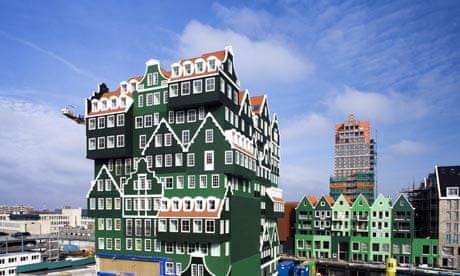Can this be real? I'm in Zaandam, near Amsterdam, standing in front of a hotel that looks like a pileup of traditional Dutch houses, all grafted together in bright greens and blues, their pediments, gables, windows and roofs pulling and pushing at my eyes.
My mind is not, however, playing tricks on me. And no, this is not an April Fool. This is the Hotel Inntel Zaandam, a madcap fairytale of a building. In fact, this 12-storey structure is, for a while, hard to take in. It looks like a trick, a conjuring act, as if some maverick architect ran off to join the circus, and learned how to balance one building on top of another, possibly while riding a bike. It's a stupefying, funny, delightful building – a quirky addition to the skyline of Zaandam, capital of the Zaanstad region and a town best known (until now) for its cocoa, biscuits and Europe's first McDonald's.
"I didn't set out to shock," says Wilfried van Winden, chief architect of WAM, the Delft-based practice behind it. "But this is, of course, an outspoken building. And the language it speaks is the architectural language of Zaanstad. It makes a big statement, sure, but the building is not an imposition – it belongs here." All the facades you see, explains the architect, are based on traditional Zaanstad houses. "From a stately notary's dwelling," he says, "to workers' cottages." Van Winden's favourite is a re-creation, high up, of a blue house that features in a work by Claude Monet, painted during a trip to Zaandam.
Funny buildings rarely come off. There was a painful period, not so long ago, when architects worldwide practised a style we learned to call post-modernism. This mostly involved the cutting and pasting of historic building details on to office blocks, shops and hotels in a puerile attempt to make big new buildings – blocky by nature – lively and entertaining, as if every town could be improved by looking like Las Vegas.
The one country to hold out against this was the Netherlands. Instead, the Dutch pioneered a line of cool, calm and collected urban buildings that have long been held up as a model of modesty, intelligence and decorum. Yet there is also an exuberant tradition in Dutch architecture that has been sidelined in recent decades. One has only to think of the extraordinary housing complex in Amsterdam called Het Schip (the Ship). Built in 1917, with soaring prows, a mast-like tower and a wealth of ornamentation, it shows that Dutch architecture over the past 100 years has been a rich affair.
During the last decade, new forms of neo-traditional buildings have sprouted in Dutch towns. Many are kitsch, but some are wholesome, appropriate and well handled. WAM's hotel, however, is in a class of its own; it will certainly put Zaandam on the tourist map. "The best compliment I've had," says Van Winden, "is from friends who say the building makes them smile. This should be enough for any architect."
Curiously, this building started out as the Golden Tulip hotel, part of a small chain, but it was bought, almost immediately, by the Inntel group, who promptly changed its name. The idea for its design came to Van Winden while he was thinking about the nature of hotels in town centres. These, he thinks, should be more like a "home from home" rather than concrete boxes. In the Inntel's 160 bedrooms, everyone gets to live in a little house rather than an anonymous space that, however plush, could be in Amsterdam or Auckland. Guests are already taking photographs, so they can tell friends and family: "Look where I stayed!"
The planners said: 'Go for it!'
The hotel, which cost €15m (£13.4m), rises not from some freakishly isolated site, but from a new development of traditional streets lined with neo- traditional buildings. This might not be to everyone's taste, yet these streets and buildings root the hotel in an urban flowerbed that seems all of a piece.
A modern building of this size is not, of course, wholly traditional in construction. The core of the hotel is concrete, while the "houses" that rise up it are timber and clapboard, meaning that many of the rooms, especially the suites, really do feel like individual and even authentic houses. Cleverly, they come across as both familiar and enticingly new. The city's planners gave the hotel the green light because, although a little unusual, it fitted into the area's overall design. They were also intrigued, says Van Winden. "What they said, in a way, was, 'If you can really build this, go for it.'"
Van Winden founded WAM a year ago. As you might expect, his style is hard to pin down. Those who might wish to caricature him as a cartoonist or a clown will be disappointed by the refined and generous Modern housing he recently designed in Amsterdam. And for all its apparent craziness, this hotel is, at heart, a rational building, with an interior that is carefully planned. While the bedrooms are essentially modern, they're adorned with images of traditional Zaandam streetscapes, as well as colourful old adverts for Zaandam cocoa powder and biscuits, blown up to cover entire walls.
Like the facades, these root the hotel firmly in Zaandam. As Van Winden says, "When you wake up here, I don't think you'll say, 'Where am I?'"
